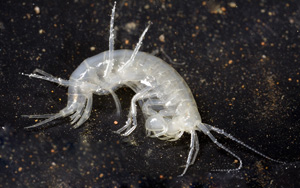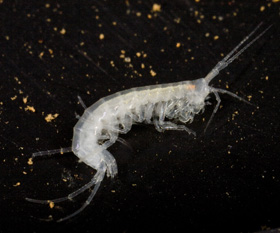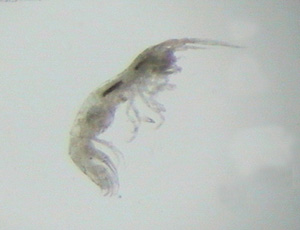 |
Cave Life of Mendip |
 |
| |
| HOME |
| INTRODUCTION |
| LIFE IN THE ENTRANCE |
| LIFE IN THE CAVE |
| CONSERVATION |
| GLOSSARY |
| ACKNOWLEDGEMENTS |
| Bacteria |
| Fungi |
| Plants, Algae & Protozoans |
| Flatworms |
| Eelworms & Segmented Worms |
| Slugs & Snails |
| Crustacea |
| Insects |
| Spiders & Millipedes |
| Fish & Amphibians |
| Birds |
| Bats |
| Fossils |
| |
Crustacea |
There are many representatives of this phylum found underground, often in water; some of them are particularly ancient and found only in caves.
The freshwater hog lice (Asellus pp.) are aquatic creatures similar in appearance to woodlice and found in streams and ponds. Asellus meridianus has been found in Swildon’s Hole and unidentified Asellus have been recorded in Great Oones Hole and Stoke Lane Slocker. These specimens have no doubt been washed in from then surface. The one in the photograph is from the lake in Pen Park Hole. The troglobite Isopod Proasellus cavaticus is usually found in cave streams on the underside of stones, on the thin film of water flowing over flowstone, and in pools. They are white, eyeless, up to 8mm long, look like undernourished woodlice and have been found in most of the major Mendip caves, including Cuckoo Cleeves, GB, Gough’s, Longwood Swallet, Cuthbert’s, Swildon’s, Tyning’s, Charterhouse Cave, Manor Farm, Waterwheel Swallet and Eastwater, as well as the Bath Stone mines at Corsham, Wiltshire. There are usually one or two specimens to be seen in the gour pools in Barnes’ Loop, Swildon’s. They are often relatively inactive and so hard to spot. In Welsh caves they are preyed on by the cave shrimp Niphargus fontanus and some flatworms (e.g. Dendrocoeleum) and it is thought that the same might occur in Mendip caves.
Amphipoda means "different-footed", and refers to the different forms of appendages these crustaceans have. Their bodies are flattened laterally (sideways) and the order includes the shrimps. Mendip caves contain five species of troglobitic cave shrimp.
Niphargus aquilex has a long thin body and can grow to 15mm long, although most specimens tend to be smaller. This is the most common species in the genus, occurring widely in groundwater across southern England and Wales. As well as caves and mines it also occurs in springs and wells. It is widespread in caves in Devon but elsewhere in the country it is only rarely found in caves, this niche usually being occupied by the more robust Niphargus fontanus. Niphargus fontanus does not occur in Devon and it might be that N. aquilex is occupying an ecological niche from which it is excluded by this species in caves further north. On the Mendips there is a single record from Rickford Farm Cave and it is also known from Holwell Cavern, another site from which N. fontanus appears to be absent.
Niphargus kochianus kochianus is generally regarded as an inhabitant of the deeper groundwater in this country and thus the fact that it has been recorded from three caves in the Mendip area is a surprise. It is far more common in deep wells and boreholes. The first record is from the Plantation Junction area of the streamway in St. Cuthbert’s Swallet in 1966. There are two records, both in 1951 from Holwell Cavern, when N. aquilex was also recorded. It is thought that both of these records could be misidentifications but these were in the days when Glenniei and Hazelton were actively running a cave research biological group and the former would have checked the specimens. Glenniei was certainly aware of the appearance of N. kochianus, having collected specimens from wells elsewhere. All other records from St. Cuthbert’s are of Niphargus fontanus and recent (1998 & 2004) visits to Holwell Cavern have only found N. aquilex. The third site for N. kochianus is Pen Park Hole, where the species was recorded in 1957 and more recently in 2004 and 2007. It can be present in fairly large numbers in the lake, which is thought to connect with the deep phreatic water table. Recent work (2010) in Swildon’s Hole found specimens of the tiny shrimp Microniphargus leruthi in the small streams of the North-west Stream Passage, Passchendaele and Black Hole Series. These are the first confirmed records of this species from Britain. It has subsequently also been identified at wells, springs and boreholes in North Devon, Dorset, Isle of Wight and Gloucestershire and from a second cave in South Devon. The species was discovered in two boreholes in Ireland in 2006 and subsequent work found it deep in riverine gravels and several caves in the Burren. It next nearest occurrence is in the caves of the Ardennes in Belgium, Luxembourg and the upper Rhine basin in Germany. It was suspected that it might occur in Britain and had been overlooked in the past, due primarily to its small size (1.5 to 2mm). It looks like a tiny Crangonyx subterraneus.
All of the above species of cave shrimps are omnivores, eating whatever source of food they can find, including dead animals, decaying plant matter and even ingesting silt to extract the micro-flora (fungi & bacteria) associated with it.
|
.jpg)
.jpg)


